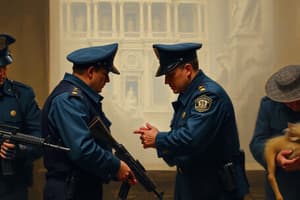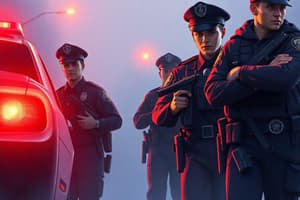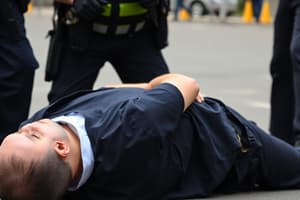Podcast
Questions and Answers
What is the primary purpose of this order?
What is the primary purpose of this order?
- To restrict the use of force by law enforcement personnel
- To judge the performance of civilian employees
- To provide guidelines on objectively reasonable response to resistance (correct)
- To specify the exact amount of force to be applied in any situation
Who is subject to the same policies and procedures as officers in incidents where they are authorized to use force?
Who is subject to the same policies and procedures as officers in incidents where they are authorized to use force?
- Members of the public
- Only sworn officers
- Civilian employees and other law enforcement agencies
- Civilian employees only (correct)
What is a critical concern to both the public and the law enforcement community?
What is a critical concern to both the public and the law enforcement community?
- The value of human life and dignity
- The authority of civilian employees
- The balancing of human interests
- The use of force by law enforcement personnel (correct)
What is recognized and respected by the Department?
What is recognized and respected by the Department?
What is understood about vesting officers with the authority to use force?
What is understood about vesting officers with the authority to use force?
What is a factor that can influence the level of force necessary in a situation?
What is a factor that can influence the level of force necessary in a situation?
What is provided by this order in terms of de-escalation?
What is provided by this order in terms of de-escalation?
What is expected of officers when making decisions about the use of force?
What is expected of officers when making decisions about the use of force?
What is the primary goal of an officer's assessment when arriving on the scene?
What is the primary goal of an officer's assessment when arriving on the scene?
What is a factor to consider when deciding whether de-escalation is appropriate?
What is a factor to consider when deciding whether de-escalation is appropriate?
What is an example of a contingency that may arise during an incident?
What is an example of a contingency that may arise during an incident?
What is the purpose of securing additional resources during de-escalation?
What is the purpose of securing additional resources during de-escalation?
What is an example of tactical repositioning during de-escalation?
What is an example of tactical repositioning during de-escalation?
Why is effective communication crucial during de-escalation?
Why is effective communication crucial during de-escalation?
What is the role of supervisors in ensuring de-escalation techniques are used?
What is the role of supervisors in ensuring de-escalation techniques are used?
What is the purpose of an officer's assessment in determining the totality of circumstances?
What is the purpose of an officer's assessment in determining the totality of circumstances?
What is an example of a resource that may be used during de-escalation?
What is an example of a resource that may be used during de-escalation?
What is the primary purpose of the de-escalation order?
What is the primary purpose of the de-escalation order?
What is the definition of 'bodily injury' according to the Tex.Penal Code?
What is the definition of 'bodily injury' according to the Tex.Penal Code?
What is the goal of de-escalation techniques?
What is the goal of de-escalation techniques?
What is an officer's duty when observing another officer using force that is not objectively reasonable?
What is an officer's duty when observing another officer using force that is not objectively reasonable?
What is the purpose of de-escalation techniques?
What is the purpose of de-escalation techniques?
What is the definition of 'serious bodily injury'?
What is the definition of 'serious bodily injury'?
What should officers do when it is not already reasonably known by the subject to be searched or arrested?
What should officers do when it is not already reasonably known by the subject to be searched or arrested?
What is the purpose of an officer's report when witnessing the use of objectively unreasonable force?
What is the purpose of an officer's report when witnessing the use of objectively unreasonable force?
What is the definition of 'deadly force'?
What is the definition of 'deadly force'?
When may officers abandon de-escalation efforts?
When may officers abandon de-escalation efforts?
What is the purpose of the General Order 200?
What is the purpose of the General Order 200?
When dealing with an agitated subject, what is the primary goal of using verbal techniques?
When dealing with an agitated subject, what is the primary goal of using verbal techniques?
Which of the following is an example of passive resistance?
Which of the following is an example of passive resistance?
What is the primary factor in determining the level of force to be used by an officer in a force encounter?
What is the primary factor in determining the level of force to be used by an officer in a force encounter?
What is the purpose of providing the subject with alternatives during a encounter?
What is the purpose of providing the subject with alternatives during a encounter?
What is the primary difference between defensive resistance and passive resistance?
What is the primary difference between defensive resistance and passive resistance?
What is the highest level of resistance that can be exhibited by a subject?
What is the highest level of resistance that can be exhibited by a subject?
What is the role of situational context in determining the level of resistance exhibited by a subject?
What is the role of situational context in determining the level of resistance exhibited by a subject?
What is the purpose of providing the subject with reasonably sufficient time to respond to directives?
What is the purpose of providing the subject with reasonably sufficient time to respond to directives?
What is an example of a preparatory action indicating greater resistance?
What is an example of a preparatory action indicating greater resistance?
What is the role of the officer's presence and verbal commands in dealing with compliant subjects?
What is the role of the officer's presence and verbal commands in dealing with compliant subjects?
What is the minimum level of force required to mandate a Response to Resistance report?
What is the minimum level of force required to mandate a Response to Resistance report?
What is the primary consideration for an officer's response to resistance?
What is the primary consideration for an officer's response to resistance?
Who is considered medical personnel in the context of assisting medical professionals?
Who is considered medical personnel in the context of assisting medical professionals?
Under what circumstances can an officer deviate from standard tools and methods?
Under what circumstances can an officer deviate from standard tools and methods?
What is the title code of the incident report that must be completed after using a level of force greater than holding?
What is the title code of the incident report that must be completed after using a level of force greater than holding?
What is required of an officer who uses a level of force greater than holding to assist medical personnel?
What is required of an officer who uses a level of force greater than holding to assist medical personnel?
What is the purpose of an officer's ongoing assessment in a situation?
What is the purpose of an officer's ongoing assessment in a situation?
What is the purpose of the General Orders 211 and 200.5.1 in relation to assisting medical professionals?
What is the purpose of the General Orders 211 and 200.5.1 in relation to assisting medical professionals?
What is a characteristic of an objectively reasonable response to resistance?
What is a characteristic of an objectively reasonable response to resistance?
What is prohibited for officers to use in any situation, except for a lethal force encounter?
What is prohibited for officers to use in any situation, except for a lethal force encounter?
What is an example of preparatory actions indicating greater resistance?
What is an example of preparatory actions indicating greater resistance?
What is the policy of the department regarding the use of force?
What is the policy of the department regarding the use of force?
What is the officer's responsibility in articulating the specific observations and actions displayed by the subject?
What is the officer's responsibility in articulating the specific observations and actions displayed by the subject?
What is a factor that may influence the officer's response to resistance?
What is a factor that may influence the officer's response to resistance?
What is the purpose of an officer's assessment of the subject's resistance?
What is the purpose of an officer's assessment of the subject's resistance?
What is the primary consideration when evaluating the objective reasonableness of force in a particular situation?
What is the primary consideration when evaluating the objective reasonableness of force in a particular situation?
In which scenario is an officer justified in using reasonable force?
In which scenario is an officer justified in using reasonable force?
Which of the following is a factor to consider when determining whether an officer has used objectively reasonable force?
Which of the following is a factor to consider when determining whether an officer has used objectively reasonable force?
When is an officer justified in using deadly force against another?
When is an officer justified in using deadly force against another?
What is the ultimate objective of every law enforcement encounter?
What is the ultimate objective of every law enforcement encounter?
What is required when an officer is confronted with a situation where the use of force is necessary?
What is required when an officer is confronted with a situation where the use of force is necessary?
Which of the following is not a factor to consider when determining whether an officer has used objectively reasonable force?
Which of the following is not a factor to consider when determining whether an officer has used objectively reasonable force?
What is a primary consideration for an officer when deciding whether to immediately apprehend a subject?
What is a primary consideration for an officer when deciding whether to immediately apprehend a subject?
What is the purpose of reporting incidents of response to resistance force?
What is the purpose of reporting incidents of response to resistance force?
What is the standard for evaluating the use of force in a particular situation?
What is the standard for evaluating the use of force in a particular situation?
Who is required to be notified as soon as practicable following any force incident or allegation of force?
Who is required to be notified as soon as practicable following any force incident or allegation of force?
What is the primary consideration when evaluating the use of deadly force?
What is the primary consideration when evaluating the use of deadly force?
What is the primary purpose of documenting a response to resistance in an appropriate report?
What is the primary purpose of documenting a response to resistance in an appropriate report?
What is a consideration for officers when encountering a subject who appears to be highly intoxicated?
What is a consideration for officers when encountering a subject who appears to be highly intoxicated?
What is a characteristic of a subject exhibiting 'sudden tranquility'?
What is a characteristic of a subject exhibiting 'sudden tranquility'?
What is required of officers when a subject refuses medical attention?
What is required of officers when a subject refuses medical attention?
What is a consideration for officers when responding to a subject affected by a chemical agent?
What is a consideration for officers when responding to a subject affected by a chemical agent?
What is the role of medical personnel in responding to a subject who has been subjected to a use of force?
What is the role of medical personnel in responding to a subject who has been subjected to a use of force?
What is a consideration for officers when encountering a subject who may be pregnant?
What is a consideration for officers when encountering a subject who may be pregnant?
What is the purpose of documenting the circumstances that make provision of medical care impractical or impossible?
What is the purpose of documenting the circumstances that make provision of medical care impractical or impossible?
Flashcards are hidden until you start studying
Study Notes
Philosophy of Law Enforcement
- The use of force by law enforcement is a critical concern for both the public and the law enforcement community.
- The department recognizes and respects the value of all human life and dignity without prejudice.
- Officers should recognize that their conduct prior to the use of force may be a factor that influences the level of force necessary in a situation.
Definitions
- Bodily Injury: Physical pain, illness, or any impairment of physical condition.
- Serious Bodily Injury: Bodily injury that creates a substantial risk of death or causes death, serious permanent disfigurement, or protracted loss or impairment of the function of any bodily member or organ.
- De-escalation: Using techniques to stabilize the situation and reduce the immediacy of the threat, so that more options and resources are available to bring about a successful resolution to an encounter with a non-compliant subject.
- De-escalation Techniques: Communicative or other actions used by officers to increase the likelihood of gaining voluntary compliance from a non-compliant subject and reduce the likelihood of using force in response to resistance.
- Deadly Force: Force that is intended or known by the officer to cause, or in the manner of its use or intended use is capable of causing, death or serious bodily injury.
- Force: Any physical contact with a subject by an officer using the body or any object, device, or weapon, not including unresisted escorting or handcuffing a subject.
- Non-Deadly Force: Any application of force other than deadly force.
- Objectively Reasonable: An objective standard viewed from the perspective of a reasonable officer on the scene, without the benefit of 20/20 hindsight, and within the limitations of the totality of the circumstances presented at the time of the incident.
Duty to Intervene
- Any officer who observes another officer using force that is not objectively reasonable shall immediately intervene to stop or prevent the use of force or further use of force.
- Officers intervening shall take effective and escalating measures to stop or prevent the use of force or further use of force.
Notice of Authority and Identity
- Officers should make clear their intent to arrest or search and identify themselves as a peace officer before using force.
Response to Resistance
- The use of force by an officer must be objectively reasonable and necessary to accomplish a legitimate law enforcement purpose.
- The decision to use force is dependent upon the suspect's level of resistance, the threat reasonably posed by the suspect to the officer or another, and the totality of the circumstances known to the officer at that time.
- Types of resistance:
- No resistance (compliant)
- Passive resistance (non-compliant)
- Defensive resistance
- Aggressive resistance
- Deadly resistance
De-escalation
- When safe and reasonable under the totality of the circumstances, officers shall use de-escalation techniques to reduce the likelihood of force and increase the likelihood of voluntary compliance.
- De-escalation techniques may involve:
- Securing additional resources
- Tactical repositioning
- Verbal persuasion
Assessing Risks and Benefits
- Officers should consider the following factors when assessing risks and benefits:
- Risks and benefits associated with delaying immediate action
- Contingencies that may arise
- Need for a supervisor's response
- Need for other officers or special units
- Availability of other resources
- Ability to communicate effectively with the subject### Factors Considered in Use of Force
- Seriousness of the suspected offense or reason for contact with the individual
- Training and experience of the officer
- Potential for injury to citizens, officers, and subjects
- Risk of escape
- Whether the conduct of the individual being confronted no longer reasonably appears to pose an imminent threat to the officer or others
- Exigent circumstances
Use of Force to Affect a Detention, an Arrest, or to Conduct a Search
- Officer is justified in using reasonable force when they reasonably believe it is immediately necessary
- To make or assist in a detention or an arrest, or to conduct a search that the officer reasonably believes is lawful
- To prevent or assist in preventing escape after an arrest, provided the officer reasonably believes the arrest or search is lawful
- To make an arrest or conduct a search under a warrant that the officer reasonably believes is valid
Deadly Force Applications
- Officer has no duty to retreat and is only justified in using deadly force against another when and to the extent the officer reasonably believes the deadly force is immediately necessary to:
- Protect themselves or others from an imminent threat of death or serious bodily injury
- Make an arrest or to prevent escape after arrest when the officer has probable cause to believe that the subject has committed or intends to commit an offense involving serious bodily injury or death, or that there is an imminent or potential risk of serious bodily injury or death to any other person if the subject is not immediately apprehended
Reporting the Response to Resistance
- Any response to resistance by a member of this department shall be documented promptly, completely, and accurately in an appropriate report
- Supervisor notification shall be made as soon as practicable following any force incident or allegation of force
Duty to Give Aid and Medical Care
- Medical care shall be obtained for any subject who has sustained a visible injury, complained of injury or continuing pain, was rendered unconscious, or may otherwise require medical assistance
- Medical assistance may consist of examination by fire personnel, paramedics, hospital staff, or medical staff at the jail
- Officers shall inform any person providing medical care that the person receiving care has been subjected to a use of force
- Subjects exhibiting unusual agitation, aggression, or similar behaviors shall be provided special care and medical attention
Studying That Suits You
Use AI to generate personalized quizzes and flashcards to suit your learning preferences.





